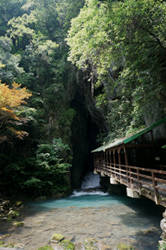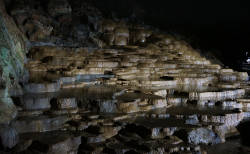秋芳洞
Akiyoshidō - Akiyoshi-do - Akiyoshi Cave
Useful Information

| Location: |
Akiyoshidai, Syuuhou-tyo, Yamaguchi.
40 minute bus ride from Jr Ogori Station. 5 min from Akiyoshidai IC in Ogōri-Hagi Expressway via Mine Higashi JCT in Chūgoku Expressway. (34.226615, 131.304756) |
| Open: |
Main entrance:
MAR to NOV daily 8:30-18:30, last entry 17:30.
DEC to FEB daily 8:30-17:30, last entry 16:30.
Elevator entrance: all year daily 8:30-17:30, last entry 16:30. Kurotani entrance: all year daily 8:30-17:30, last entry 16:30. [2020] |
| Fee: |
Adults JPY 1,300, Children (15-17) JPY 1,300, Children (12-14) JPY 1050, Children (6-11) JPY 700. Groups (20+): Adults JPY 1,100, Children (15-17) JPY 9050, Children (12-14) JPY 800, Children (6-11) JPY 550. Reservation required. [2020] |
| Classification: |
 Karst Cave
Paleozoic limestone, coral reef. Karst Cave
Paleozoic limestone, coral reef.
|
| Light: |
 Electric Light Electric Light
|
| Dimension: | L=10,300 m, T=17 °C |
| Guided tours: |
self guided, L=1,000 m, D=60 min.
Audio guide:




|
| Photography: | allowed |
| Accessibility: | partly wheelchair accessible from Akiyoshidō Entrance to Hyakumaizara. |
| Bibliography: |
George Edward Gauntlett (1909):
The Caves of Yamaguchi,
The Yorkshire Ramblers’ Club Journal 3 (9) 41-44
H S Torii (1957-59): Kurze Geschichte der Höhlen- und Karstforschung in Japan, [A short history of caves and karst exploration in Japan]. Die Höhle, 8 (4) 104-107; 9 (2) 37-40; 10 (1) 11, 10 (4) 99-102 Kanato Ando (2019); The study of amphipods in rimstone pools of Akiyoshi-do Cave, Japan. Subterranean Biology. 32. 81-94. 10.3897/subtbiol.32.35031. |
| Address: | Akiyoshidō, 3506-2 Akiyoshi, Shūhō-chō, Mine-shi, 754-0511, Tel: +81-837-62-0304. |
| As far as we know this information was accurate when it was published (see years in brackets), but may have changed since then. Please check rates and details directly with the companies in question if you need more recent info. |
|
History

| 1354 | to end a draught Zen master Ohora Kotobuki performs a ritual, in the floods caused by the 37 days rain a monk dies. |
| 1729 | graffiti in the cave show the names Takinoguchi, Hirotaki, and Inagawa. |
| 1904 | first written mention in Japanese (Torii 1957-59). |
| 1907 | survey by George Edward Gauntlet, an English schoolmaster, who was commissioned by Bunjiro Umehara mining company. He published his results in 1909 in Yorkshire. |
| 1909 | cave developed as a show cave by Bunjirō Umehara and opened to the public. |
| 1920 | first detailed survey map by the Ministry of Home Affairs Natural Monument Study Team. |
| 1922 | designated a National Natural Monument. |
| 1925 | electric light installed. |
| 30-MAY-1926 | visited by the Crown Prince Hirohito who renamed the cave Akiyoshidō. |
| 01-NOV-1955 | Akiyoshidai Quasi-National Park established. |
| 1956 | elevator into the cave installed. |
| 1960 | electric light for the huge halls with mercury lamps. |
| 1960 | cave surveyed to a length of 2 km. |
| 1963 | Kurodani entrance tunnel constructed. |
| 2000 | cave surveyed to a length of 8.5 km. |
| 2015 | Mine Akiyoshidai established as Japanese Geopark. |
| 2016 | cave surveyed to a length of 10,300 m by the Akiyoshidai Karst Cave Academic Research Team. |
Description

秋芳洞 (Akiyoshidō) was originally named Takiana (waterfall hole), but was renamed in 1926 by the Crown Prince Hirohito. He visited the cave, when he was still the crown prince. He became the emperor 昭和天皇 (Shōwa-tennō) in the same year in December, when his father died.
The cave system is more than 10 kilometers long and currently the third-longest cave of Japan [2020]. Japan is mostly of volcanic origin, and there are only patches of limestone, so there are no really long caves, but the Akiyoshidai karst plateau is quite large (~130 km²) and full of caves. The limestone is important for many things in the modern world, so there are numerous limestone quarries in the area.
Akiyoshidō has three entrances. The Akiyoshidō Entrance is the natural entrance which follows the cave river into the resurgence. To allow visitors to enter here, a wooden walkway was constructed at the side wall, several meters above the river. The trail follows the main passage along the cave river, first it is almost level but later the trail starts to ascend. At some point the fossil Kurotani passage branches off to the left. Here is the location of an elevator where visitors are transported to the surface and a viewing platform. The trail now follows the Kurotani passage, which ends at the Kurotani Entrance. This entrance is an artificial tunnel which is called 300 Million-Year Time Tunnel, a hint at the age of the limestone.
The cave is visited self-guided, but there are audio guides available in various languages. A typical round trip is, to start at the Akiyoshidō entrance, go to the elevator, visit the viewing platform, then go back down and continue to the Kurotani entrance. Then walk back to the Akiyoshidō entrance. However, as the tour is self-guided you can skip any part or start from any of the three entrances. The ticket allows to leave the cave, e.g. for the viewing platform, and re-enter later. Also photography is allowed and on self-guided tours there is enough time to take a few exceptional pictures.
The cave river is known for various endemic troglobiont species which were found here. There is even a so-called Animal Lookout for the visitors. But we guess you must be very lucky to see anything, most likely they fled the light and the commotion of the visitors. It is much easier to see one of the 15,000 bats which live in the cave. Six different species have so far been determined.
The largest hall of the cave is named Senjoji and is 175 m long, 80 m wide and 35 m high. Kotogafuchi, the largest lake of the cave, is 60 m long, 15 m wide and 3 m deep. Some formations are quite spectacular, for example Kurage no Taki Nobori, a huge stalagmite which looks as if "countless jellyfish are climbing the waterfall". Or probably it looks like the Alien designs by H. R. Giger. Hyakumaizara (hundred saucers) is a spectacular series of rimstone pools. The rims are not as high as those in Pammukkale or Skocjanske Jame, but they are the most spectacular rimstone pools in a Japanese show cave. And then there are the Koganebashira (Golden Pillars), a series of very long and straight stalactites with a golden colour. A bit strange is that the names of the speleothems are listed as sights or caves or geological monuments in some portals. Be aware, these are not locations or special tours, these are the names of the speleothems which can be seen on the regular tour through Akiyoshidō.
You can complete the trip with a short walk on the limestone plateau, which is full of typical karren structures. Close to the elevator entrance is the 秋吉台科学博物館 (Akiyoshidai Science Museum). It is dedicated to the karst area, the caves and springs. A short trip to the Beppu Benten Pond, a karst spring only 10 km from the cave, is recommended. The Mine Akiyoshidai Geopark Center Karstar is a good start for an excursion to this area. The area is a Quasi National Park and a National Geopark, a Ramsar Site and wetland of international importance.
The natural entrance is at the foot of a 50 m high cliff. The entrance is 20 m high and 8 m wide. The tourist route runs parallel to an underground stream, and passes a complex of 500 terraced rimstone pools, large stalagmites, and large columns. Claimed to be the largest and the most splendid cave in Asia.
Text by Tony Oldham (2004). With kind permission.
- See also
 Search DuckDuckGo for "Akiyoshi Cave"
Search DuckDuckGo for "Akiyoshi Cave" Google Earth Placemark
Google Earth Placemark Akiyoshidai Quasi-National Park - Wikipedia (visited: 02-MAY-2020)
Akiyoshidai Quasi-National Park - Wikipedia (visited: 02-MAY-2020) 秋芳洞 - Wikipedia (visited: 02-MAY-2020)
秋芳洞 - Wikipedia (visited: 02-MAY-2020) Akiyoshidō, officiel website (visited: 19-JUN-2019)
Akiyoshidō, officiel website (visited: 19-JUN-2019) Akiyoshido Cave - Atlas Obscura (visited: 01-MAY-2020)
Akiyoshido Cave - Atlas Obscura (visited: 01-MAY-2020) Akiyoshidō and Akiyoshidai (visited: 02-MAY-2020)
Akiyoshidō and Akiyoshidai (visited: 02-MAY-2020) Akiyoshi Tropfsteinhöhle
Akiyoshi Tropfsteinhöhle  (visited: 19-JUN-2019)
(visited: 19-JUN-2019) Akiyoshidai (visited: 02-MAY-2020)
Akiyoshidai (visited: 02-MAY-2020) Akiyoshi Cave (visited: 02-MAY-2020)
Akiyoshi Cave (visited: 02-MAY-2020) Akiyoshi Cave (visited: 02-MAY-2020)
Akiyoshi Cave (visited: 02-MAY-2020) These postcards were published around 1965. (visited: 02-MAY-2020)
These postcards were published around 1965. (visited: 02-MAY-2020) Akiyoshidai Science Museum
Akiyoshidai Science Museum  (visited: 02-MAY-2020)
(visited: 02-MAY-2020) Akiyoshidai karst plateau (visited: 25-FEB-2022)
Akiyoshidai karst plateau (visited: 25-FEB-2022)
 Index
Index Topics
Topics Hierarchical
Hierarchical Countries
Countries Maps
Maps